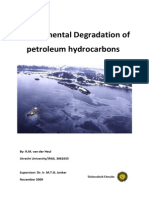Resume N
Resume N
Uploaded by
Jose TiburcioCopyright:
Available Formats
Resume N
Resume N
Uploaded by
Jose TiburcioOriginal Description:
Original Title
Copyright
Available Formats
Share this document
Did you find this document useful?
Is this content inappropriate?
Copyright:
Available Formats
Resume N
Resume N
Uploaded by
Jose TiburcioCopyright:
Available Formats
STUDY OF PHOTODEGRADATION PROCESS OF DL-ALPHA-TOCOPHEROL (VITAMIN E) BY THERMAL LENS, OPTICAL ABSORPTION AND EMISSION SPECTROSCOPY J.A. Tiburcio-Moreno1, G.
Marcelin1, O.L. Leanos-Castaneda1, J.M. Yanez-Limon2 and J. J. AlvaradoGil1
1
Department of Applied Physics, CINVESTAV-Unidad Mrida, Antigua Carretera a Progreso Km. 6, 97310, Mrida,Yucatn, Mxico.
2
Materials and Engineering Science, CINVESTAV-IPN, Unidad Quertaro, Libramiento norponiente No.
2000 Fracc. Real de Juriquilla, C.P. 76230 Quertaro, Quertaro, Mxico.
ABSTRACT Alpha-tocopherol is a liposoluble vitamin which presents natural antioxidant properties [1]. One of the most important issues has to do with the preservation of the integrity of vitamin E. This work presents a study of the photodegradation process induced by UV radiation of vitamin E at three different concentrations (10, 1 and 0.1 mg/ml). The process was analyzed by thermal lens technique, UV-Vis spectroscopy, fluorescence and liquid chromatography. In the case of the UV-Vis spectroscopy measurements, the degradation was induced by ultraviolet radiation at 266 nm and 366 nm. The highest concentration of Vitamin E show a characteristic absorbance band at 292 nm [2], that when irradiated with a wavelength of 266 nm, the spectrum exhibits an additional absorption band at 368nm. This effect can be related to the process of photodegradation of vitamin E, whose intensity increases with increasing time of exposure to UV radiation. After 60 min of UV exposure the band shows no evolution and the effect due to irradiation is permanent. The effect of photodegradation was also observed in the emission spectra. In this case excitation bands at 292 and 368 nm were used. With the excitation at 292 nm, an emission band is observed around 350 nm for t = 0, which decreases in intensity for longer time. For the excitation band at 368 nm, no emission is observed initially, however for t = 10 min an emission band appears at about 520 nm which initially increases in intensity and for longer times (30 min) decreases. Lower concentration samples show similar effects but the stabilization time intervals were smaller. Thermal lens measurements of the degradation process induced by 266nm, and induced with a 488nm laser source, did not show observable effects in the initial stages. However in the consecutive stages the value of the signal increases followed by a decrease and reaches stability in the last stages. REFERENCES [1] Webster R.D.; Electrochem. Commun. 1999, 1, 581. [2] Giacomelli C.; J. Braz. Chem. Soc., 15, 748-755, 2004.
You might also like
- Lab 05 Effect of UV Radiation On BacteriaDocument6 pagesLab 05 Effect of UV Radiation On BacteriaPINAKI100% (3)
- Endogenous Glutathione Protects Human Skin Fibroblasts Against The Cytotoxic Action of Uvb, Uva and Near-Visible RadiationsDocument4 pagesEndogenous Glutathione Protects Human Skin Fibroblasts Against The Cytotoxic Action of Uvb, Uva and Near-Visible RadiationsmehmetozsavciNo ratings yet
- Depletion of Human Stratum Corneum Vitamin E: An Early and Sensitive in Vivo Marker of UV Induced Photo-OxidationDocument6 pagesDepletion of Human Stratum Corneum Vitamin E: An Early and Sensitive in Vivo Marker of UV Induced Photo-OxidationumegeeNo ratings yet
- Effects of UV Radiation On Photosynthesis of Phytoplankton Exposed To Solar Simulator LightDocument8 pagesEffects of UV Radiation On Photosynthesis of Phytoplankton Exposed To Solar Simulator LightAlexsandro ClaudinoNo ratings yet
- 2024-07-16T115005.542Document4 pages2024-07-16T115005.542moulabip.openventioNo ratings yet
- Ultraviolet Light Induced Injury: Immunological and Inflammatory EffectsDocument22 pagesUltraviolet Light Induced Injury: Immunological and Inflammatory EffectsMayna KesumaNo ratings yet
- Introduction To Basic RadiotherapyDocument54 pagesIntroduction To Basic Radiotherapyhendra2darmawanNo ratings yet
- Radiation Toxicity: 31.1 Principles of RadioactivityDocument9 pagesRadiation Toxicity: 31.1 Principles of RadioactivityVarshith GandlaNo ratings yet
- RPNM Part02 Physics WEBDocument102 pagesRPNM Part02 Physics WEBLouis FortunatoNo ratings yet
- BMS1031 Week 11 Workshop - 2023Document13 pagesBMS1031 Week 11 Workshop - 2023yuydream777No ratings yet
- M GhelmeyDocument8 pagesM GhelmeyGheorghe AncaNo ratings yet
- Effects of Ionizing Radiation On Microbiological Contaminants of FoodsDocument9 pagesEffects of Ionizing Radiation On Microbiological Contaminants of FoodsMaria EduardaNo ratings yet
- Expirement 3 EletricalDocument1 pageExpirement 3 EletricalNdavi KiangiNo ratings yet
- Genotoxicity of visible light (400–800 nm) and photoprotectionDocument11 pagesGenotoxicity of visible light (400–800 nm) and photoprotectionshelly.caoNo ratings yet
- 830 NM Laser Irradiation Induces Varicosity Formation, Reduces Mitochondrial Membrane Potential and Blocks Fast Axonal Flow in SDocument1 page830 NM Laser Irradiation Induces Varicosity Formation, Reduces Mitochondrial Membrane Potential and Blocks Fast Axonal Flow in Sxy8brvx2qmNo ratings yet
- Yba2Cu307: Laser Irradiation Effects in Amorphous FilmsDocument2 pagesYba2Cu307: Laser Irradiation Effects in Amorphous Filmsroyhiranmay94No ratings yet
- NDJ 2Document6 pagesNDJ 2LirofiatillahNo ratings yet
- Apeksha FinalDocument26 pagesApeksha FinalAshish MOHARENo ratings yet
- 11725748Document30 pages11725748usman khanNo ratings yet
- Investigation of Photoneutron Dose Equivalent From High-Energy Photons in RadiotherapyDocument6 pagesInvestigation of Photoneutron Dose Equivalent From High-Energy Photons in RadiotherapyChun-Chih LinNo ratings yet
- Sept. 2014. 1. Interaksi Radiasi Elektro - Materi AccDocument17 pagesSept. 2014. 1. Interaksi Radiasi Elektro - Materi AccJeffrey RamosNo ratings yet
- UVRDocument62 pagesUVRkumarNo ratings yet
- Apeksha FinalDocument25 pagesApeksha FinalAshish MOHARENo ratings yet
- Reduction and Analysis Methods of IndigoDocument72 pagesReduction and Analysis Methods of IndigoBilal MasoodNo ratings yet
- Phan 2016Document11 pagesPhan 2016Duccio Rossi Degl InnocentiNo ratings yet
- Solar Light Driven Degradation of Eriochrome Black T by PhotocatalysisDocument8 pagesSolar Light Driven Degradation of Eriochrome Black T by PhotocatalysisInternational Organization of Scientific Research (IOSR)No ratings yet
- Per Rella 2019Document36 pagesPer Rella 2019horenhop pyparousNo ratings yet
- Efficacy of Pulsed 405-nm Light-Emitting Diodes For Antimicrobial Photodynamic Inactivation: Effects of Intensity, Frequency, and Duty CycleDocument7 pagesEfficacy of Pulsed 405-nm Light-Emitting Diodes For Antimicrobial Photodynamic Inactivation: Effects of Intensity, Frequency, and Duty CycleTu BeeNo ratings yet
- Anti-Inflammatory Effect of Laser Acupuncture in ST36 (Zusanli) Acupoint in Mouse Paw EdemaDocument9 pagesAnti-Inflammatory Effect of Laser Acupuncture in ST36 (Zusanli) Acupoint in Mouse Paw EdematyanafmNo ratings yet
- Pengaruh Intensitas, Lama Waktu Penyinaran Dan Posisi Sumber Sinar Ultraviolet Terhadap Reduksi Jumlah Bakteri E.Coli Pada Air SumurDocument12 pagesPengaruh Intensitas, Lama Waktu Penyinaran Dan Posisi Sumber Sinar Ultraviolet Terhadap Reduksi Jumlah Bakteri E.Coli Pada Air SumurAli ShodiqNo ratings yet
- 2019 - Photochemical Activity of Cattleya Harrisoniana (Orchidaceae) Under SunflecksDocument5 pages2019 - Photochemical Activity of Cattleya Harrisoniana (Orchidaceae) Under Sunflecksvictoralyson360No ratings yet
- Lecture 5 Solar Radiation Part 1 Principles Notes PDFDocument21 pagesLecture 5 Solar Radiation Part 1 Principles Notes PDF॰अचूक॰ Milan SubediNo ratings yet
- Assignment Nuclear Chemistry JH Sir-3530Document15 pagesAssignment Nuclear Chemistry JH Sir-3530asdasdNo ratings yet
- In Uence of Light Intensity, Spectrum and Orientation On Sea Bass Plasma and Ocular MelatoninDocument7 pagesIn Uence of Light Intensity, Spectrum and Orientation On Sea Bass Plasma and Ocular MelatoninMarko PotočnikNo ratings yet
- Modelling of Post-Irradiation Events in Polymer Gel DosimetersDocument14 pagesModelling of Post-Irradiation Events in Polymer Gel DosimetersIsmaliza IshakNo ratings yet
- LLLT For Mitochondiral Respiratory Chain PDFDocument4 pagesLLLT For Mitochondiral Respiratory Chain PDFRaffael DauhanNo ratings yet
- Estudo Do LiFDocument4 pagesEstudo Do LiFBruninha NovaisNo ratings yet
- Generation and Characterization of 1,2-Diaryl-1,1,2,2-Tetramethyldisilane Cation RadicalsDocument6 pagesGeneration and Characterization of 1,2-Diaryl-1,1,2,2-Tetramethyldisilane Cation RadicalsDiogomussumNo ratings yet
- Performance of Composite Insulators With and Without Bio ContaminationDocument4 pagesPerformance of Composite Insulators With and Without Bio ContaminationSiva KumarNo ratings yet
- Study of Morphological and Histological Changes in Melon Plants Grown From Seeds Irradiated With UV-BDocument6 pagesStudy of Morphological and Histological Changes in Melon Plants Grown From Seeds Irradiated With UV-BShailendra RajanNo ratings yet
- Karu 1989Document14 pagesKaru 1989Brenda TakagiNo ratings yet
- Holt - Roy - 2005 - Bubble Dynamics in Therapeutic UltrasoundDocument47 pagesHolt - Roy - 2005 - Bubble Dynamics in Therapeutic UltrasoundTanya FilonetsNo ratings yet
- CPO Science Foundations of Physics: Unit 9, Chapter 30Document49 pagesCPO Science Foundations of Physics: Unit 9, Chapter 30Fatin IziantiNo ratings yet
- Referência 38Document11 pagesReferência 38jmaj jmajNo ratings yet
- Yoshizawa 2009Document10 pagesYoshizawa 2009Lucia LoperaNo ratings yet
- Optical Characterization - FullDocument4 pagesOptical Characterization - FullTJPRC PublicationsNo ratings yet
- RRR 123Document7 pagesRRR 123RohiniNo ratings yet
- Photoacoustic Studies of Annealed Cdsxse1-X (X 0.26) Nanocrystals in A Glass MatrixDocument6 pagesPhotoacoustic Studies of Annealed Cdsxse1-X (X 0.26) Nanocrystals in A Glass MatrixVigneshwaran MuruganNo ratings yet
- PAS Dalam FotosintesisDocument18 pagesPAS Dalam FotosintesisFRANCISCA HTNo ratings yet
- STC 212 Theory-1-1Document47 pagesSTC 212 Theory-1-1Abdulaziz Muhammed100% (1)
- Thermal Imaging System and Its Real Time Applications: A SurveyDocument15 pagesThermal Imaging System and Its Real Time Applications: A SurveyDeepan PrasathNo ratings yet
- FTIRDocument7 pagesFTIRhuyền TrầnNo ratings yet
- 01 Radiation UnitsDocument41 pages01 Radiation UnitsFakhrul SyukriNo ratings yet
- III PhotochemistryDocument37 pagesIII PhotochemistryRujal KundhareNo ratings yet
- CRPSCI 1100-Module7Document27 pagesCRPSCI 1100-Module7carbonel.carlaNo ratings yet
- Pulsed Light Treatments For Food Preservation. A ReviewDocument11 pagesPulsed Light Treatments For Food Preservation. A ReviewPravin Zine PatilNo ratings yet
- CH. 4 Radiation 2015Document54 pagesCH. 4 Radiation 2015MaxxaM8888No ratings yet
- Solid State NMR Spectroscopy: Principles and ApplicationsFrom EverandSolid State NMR Spectroscopy: Principles and ApplicationsMelinda J. DuerNo ratings yet
- Improving Light Fastness of Natural Dyes On Cotton YarnDocument8 pagesImproving Light Fastness of Natural Dyes On Cotton YarnAnne CalyxNo ratings yet
- NCL Report - Chapter 4Document6 pagesNCL Report - Chapter 4Aparna YaduNo ratings yet
- Drug StabilityDocument97 pagesDrug StabilityKsheeteej “Beast”No ratings yet
- Photodegradation and Photostabilization of PSDocument32 pagesPhotodegradation and Photostabilization of PSMinhAnhNo ratings yet
- 369 FullDocument15 pages369 FullEstudiante2346No ratings yet
- Review On The Photocatalytic Degradation of Dyes and Antibacterial Activities of Pure and Doped-ZnoDocument13 pagesReview On The Photocatalytic Degradation of Dyes and Antibacterial Activities of Pure and Doped-ZnoDaniel SusantoNo ratings yet
- Art 00008Document7 pagesArt 00008Ariel GarciaNo ratings yet
- Physicochemical Factors Under Preformulation Study: Contents:-I. Physical Characteristics A. Bulk CharacteristicDocument18 pagesPhysicochemical Factors Under Preformulation Study: Contents:-I. Physical Characteristics A. Bulk CharacteristicFIRDA TRYANANo ratings yet
- HandlerDocument772 pagesHandlerArpita DeyNo ratings yet
- Nw20compost 20sitesDocument13 pagesNw20compost 20sitesBiodegradablePlasticNo ratings yet
- Applications of Nanotechnology in AgricultureDocument417 pagesApplications of Nanotechnology in Agricultureabderrahmanmhammad2719No ratings yet
- DEGRADATIONPATHWAY B. Pharm 2-2Document22 pagesDEGRADATIONPATHWAY B. Pharm 2-2Yuppie RajNo ratings yet
- Photostability Testing of Pharmaceutical ProductsDocument5 pagesPhotostability Testing of Pharmaceutical ProductsLone KiraNo ratings yet
- Mirkhani2009 Article PhotocatalyticDegradationOfAzoDocument10 pagesMirkhani2009 Article PhotocatalyticDegradationOfAzoAjit Kumar DhankaNo ratings yet
- Polyolefins With Controlled Environmental DegradabilityDocument12 pagesPolyolefins With Controlled Environmental DegradabilityVane Moncada ヅNo ratings yet
- In-Use Photostability Practice and Regulatory Evaluation For Pharmaceutical Products in An Age of Light-Emitting Diode Light SourcesDocument5 pagesIn-Use Photostability Practice and Regulatory Evaluation For Pharmaceutical Products in An Age of Light-Emitting Diode Light SourcesMariangel M.No ratings yet
- SCY1616Document50 pagesSCY1616MohsinAliNo ratings yet
- Zn-Fe Mixed Metal Oxide Derived From Layered Double Hydroxide-AsDocument5 pagesZn-Fe Mixed Metal Oxide Derived From Layered Double Hydroxide-Asangeluis_879728No ratings yet
- Assessmentof Microplasticsinthe Surface Waterof Sitio Pulo Navotas Metro ManilaDocument14 pagesAssessmentof Microplasticsinthe Surface Waterof Sitio Pulo Navotas Metro Manilajames.potter.1524No ratings yet
- Physics of Solar Cells: An Atom-to-Farm PerspectiveDocument14 pagesPhysics of Solar Cells: An Atom-to-Farm PerspectiveRishyavandhan VNo ratings yet
- AromaDocument7 pagesAromaAcalaNo ratings yet
- Taxanol PDFDocument47 pagesTaxanol PDFsriatul2006No ratings yet
- Photo OxidationDocument190 pagesPhoto OxidationSiva KumarNo ratings yet
- Leng 2019Document14 pagesLeng 2019farah al-sudaniNo ratings yet
- Environmental Degradation of Petroleum Hydrocarbons: By: R.M. Van Der Heul Utrecht University/IRAS, 3061655Document53 pagesEnvironmental Degradation of Petroleum Hydrocarbons: By: R.M. Van Der Heul Utrecht University/IRAS, 3061655Faiz AbdurrahmanNo ratings yet
- Green Synthesis of Nano ParticlesDocument9 pagesGreen Synthesis of Nano ParticlesSurender DilipNo ratings yet
- Astm D6954 18Document7 pagesAstm D6954 18Camilo AFNo ratings yet
- Degradasi Polimer - Lecture 2 LIADocument47 pagesDegradasi Polimer - Lecture 2 LIARangga GofranaNo ratings yet
- 2 PBDocument5 pages2 PBmusicontheroaddNo ratings yet
- Photo DegradationDocument24 pagesPhoto DegradationMaica Caguiat100% (1)

























































































